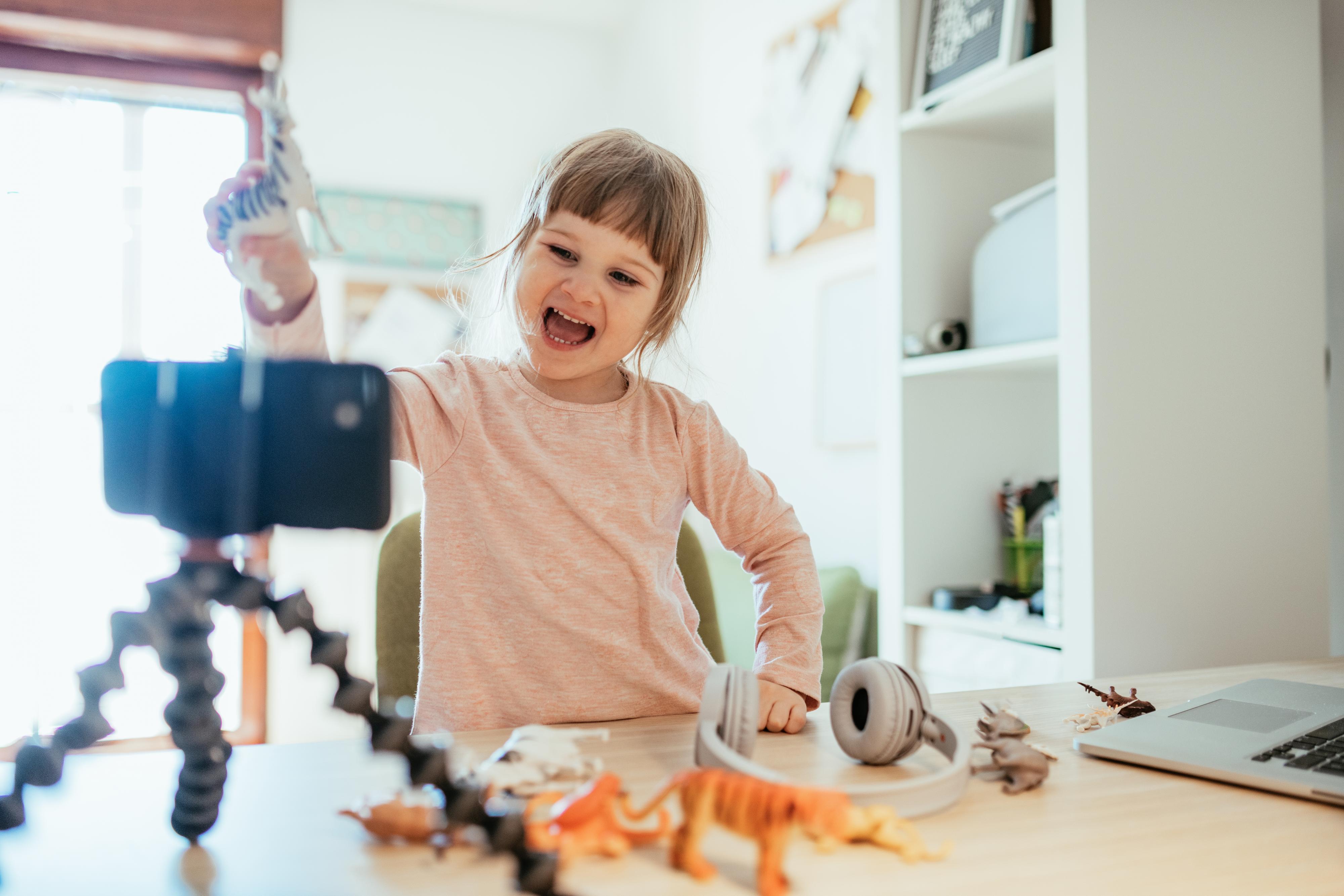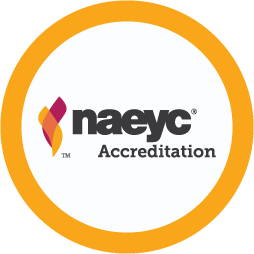Virtual Playgroups: Sparking Curiosity and Discovery

You are here
This article has been made available for free for a limited time only. Become a NAEYC member to have unlimited access to this article and so much more! Join or renew today at NAEYC.org/membership. NAEYC is here to help YOU on the journey to improve educational opportunities for all young children.
Greicy sits at her yellow plastic table waiting patiently. She claps her hands when she sees a familiar image on the computer screen, and her mom reads the message that pops up: “Welcome to WFP Virtual Playgroup. We will begin in five minutes.” Over the next half hour, Greicy will sing, engage with peers, listen to a story, and participate in a hands-on activity without having to leave the safety of her home.
A year ago, virtual playgroups like Greicy’s were rare. Children played with friends, may have attended preschool, and gathered together in a variety of settings. They shared toys, snacks, and plenty of germs without much thought or worry on their families’ parts.
 That changed with the COVID-19 pandemic, which ended most physical gatherings—particularly robust playgroups. Even though restrictions are loosening, barriers to meeting in-person remain. Still, children need the social and emotional benefits that different types of play provide, and research has shown that children learn crucial skills during play: They plan activities and negotiate with each other. They learn to advocate for themselves and work within a group. They learn to deal with frustrations and regulate their emotions.
That changed with the COVID-19 pandemic, which ended most physical gatherings—particularly robust playgroups. Even though restrictions are loosening, barriers to meeting in-person remain. Still, children need the social and emotional benefits that different types of play provide, and research has shown that children learn crucial skills during play: They plan activities and negotiate with each other. They learn to advocate for themselves and work within a group. They learn to deal with frustrations and regulate their emotions.
Like most of you, the past year has tested our community, our resolve, and our ingenuity. As part of the Worcester Family Partnership (WFP) in Worcester, Massachusetts, we run seven to nine weekly family playgroups and a home visiting program. When COVID forced an end to large gatherings, WFP worked to convert all of our in-person programming—including playgroups—to a virtual format. Children now have the opportunity to join us multiple times per week via Zoom for 30- to 45-minute sessions that address key developmental domains and offer crucial social interactions.
During the past year, we have learned a lot about what makes virtual settings successful for playgroups. Whether you’re organizing, scheduling, or hosting online gatherings for one class or a whole program, the following tips will help optimize the experience for everyone.
1. Be prepared!
Every Sunday night we email participating families the virtual meeting link, the playgroup schedule, and topics for each playgroup. We also include a list of suggested materials that families might find around their homes to use during their sessions. When possible, we provide basic supplies (paper, markers, and glue) that families can pick up in advance from a predetermined location. (To ensure safety, WFP staff wear gloves. Everyone is masked.)
2. Enlist tech support.
If possible, engage a colleague or volunteer to manage the technical side of a virtual playgroup. This person can allow access into the group, mute and unmute participants, and monitor the chat. Tech support helps the session run smoothly. It also helps the lead facilitator focus on content and connect with children.
 3. Use rituals and routines.
3. Use rituals and routines.
Establish and follow a set structure so that children learn what to expect. Our playgroup structure includes
- greetings and a song
- a story
- music or movement
- an art activity
Our sessions end with singing a goodbye song, listening to calm music, or just waving goodbye.
4. To mute or not to mute? That is the question.
We encourage social interaction among our playgroup families, but this can be challenging. We use the “mute” and “unmute” feature to eliminate background noise. This way, we ensure that we hear every family and that every family hears us. We also use the “spotlight” feature, which places a specific family on the main screen so they can be seen and heard.
Play in Virtual Settings
To find out more about the power of play and virtual settings for preschoolers, check out these resources:
- “The Power of Play: A Research Summary,” by Rachel E. White, Minnesota Children’s Museum Smart Play (2012)
- “Play and Technology: An Important Intersection for Developing Literacy,” by Victoria B. Fantozzi and colleagues in the May 2018 issue of Young Children
- “The Importance of Flexibility and Family Engagement: Connecting Virtually with Preschoolers,” by Cheryl A. Paul in the August/September 2020 issue of Teaching Young Children
To find out more about the work of the Worcester Family Partnership, please visit their website.
5. Make it personal.
Our playgroup participants change from week to week. To make sure everyone feels welcomed, we sing a “Hello Song” to greet each family by name. This helps personalize our virtual playgroups and lets families introduce themselves. In addition, we chat with families as participants sign on: We talk about how their child’s day is going; we ask questions, such as about a recent meal they shared; we ask adult caregivers how their children are responding to the virtual playground.
6. Tell us about you.
To ensure that each child has a chance to participate, we ask them to share something with the group. This could be something from their everyday lives or something that is important to them (an object, a person, or an experience). We also respect that some children may not want to talk, and we make sure they know that’s okay. By using the mute and unmute button, addressing children by name, and paying attention to their environment, we try to make everyone feel welcome and comfortable enough to speak if they’d like.
7. We like to move it, move it!
 Knowing how well children usually respond to it, we incorporate movement throughout every session. This may be a coordinated group activity, such as counting while jumping up and down, or it may be an opportunity to move after a less active segment. For example, after reading a book about shapes, we might ask the children to find something that is round in their environment to share with the group.
Knowing how well children usually respond to it, we incorporate movement throughout every session. This may be a coordinated group activity, such as counting while jumping up and down, or it may be an opportunity to move after a less active segment. For example, after reading a book about shapes, we might ask the children to find something that is round in their environment to share with the group.
8. Be mindful of time.
Our virtual playgroups last 30 to 45 minutes. They include three to five activities that address a range of developmental areas, such as math, literacy, movement, and music. We follow the lead of the families involved and are mindful that attention and engagement can vary. We monitor the children’s cues to know when it’s time to end.
Although these times are challenging, virtual playgroups offer a safe learning environment where children and families can still connect. Greicy’s mom shares that, “Greicy loves seeing all her friends at playgroup. It’s so nice for her to have something to look forward to each day.”
The Worcester Family Partnership is funded by a Coordinated Family and Community Engagement grant awarded by the Massachusetts Department of Early Education and Care through the Worcester Massachusetts Public Schools by the Department of Early Education and Care. For the past two years, WFP has participated in the Education Development Center’s Young Mathematicians in Worcester project, which is supported by funding from the National Science Foundation, Overdeck Family Foundation, and Heising Simons Foundation.
Photographs: © Getty Images.
Copyright © 2021 National Association for the Education of Young Children. See permissions and reprints online at NAEYC.org/resources/permissions.
 This article supports the following NAEYC Early Learning Programs standards and topics
This article supports the following NAEYC Early Learning Programs standards and topics
Standard 2: Curriculum
2H: Technology
Standard 3: Teaching
3B: Creating Caring Communities for Learning


Shakesha Thompson is the playgroup coordinator for Worcester Family Partnership and has worked as an early childhood educator for 17 years.
Louisa Anastasopoulos is a project director at Education Development Center Inc. in Waltham, Massachusetts.
Lori Coletti is a project director at Education Development Center Inc.